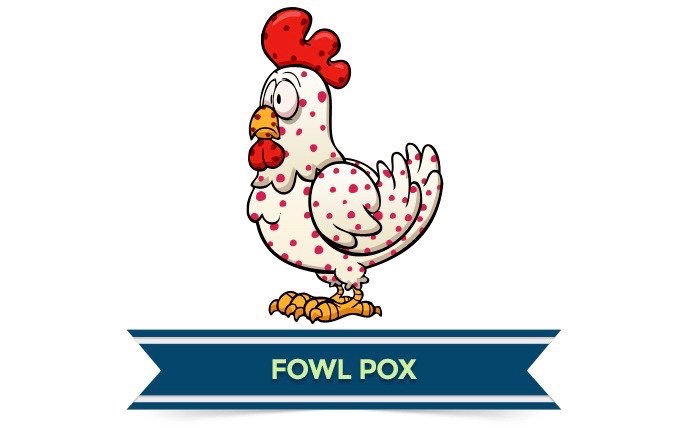Unless you’re a student of Shakespeare or archaic English you’re probably not used to hearing the term ‘pox’ very often. I never heard my father swear, but he frequently used terms like ‘hooligan’, ‘lout’ or ‘sanctimonious claptrap’. One of his favourite phrases was ‘a pox on you’, meaning intense disgust or aversion for someone. Pox, a 15th word, referred to diseases which caused blisters, boils and pock marks: Smallpox, Chicken Pox and Syphilis.
I’ve been watching with interest the increasing number of posts, accompanied by graphic photos, on Facebook chicken sites about Fowl Pox, a virus that follows in the tradition of those other infections.
I’ve never heard of Fowl Pox (FPV) in my area, largely because we don’t have high numbers of its main carrier: mosquitos. It’s a slow spreading virus characterized by lesions on unfeathered skin areas and/or mucous membranes of the mouth, larynx, trachea and esophagus.
Transmission
- Mosquitoes feeding on an infected bird are able to keep the virus in its salivary glands for up to 8 weeks. When mosquitoes bite another chicken, they are capable of transmitting the pox virus to them. One mosquito can infect several chickens after feeding on a single infected bird.
- Spreads between birds through scratches, broken skin and mucous membranes; inhaling or eating scabs; sharing waterers. It’s often associated with flock members pecking, fighting, or scratching at one another.
- Dried pox scabs that fall off of the chickens. The virus can survive in the dried scabs for months, or even years.
Symptoms
There are two types of fowl pox that infect chickens: dry (cutaneous) and wet (diphtheritic).
Dry pox, the most common form, creates small wart-like lesions on the skin of unfeathered areas (face, comb, wattles, eyelids, legs, and feet). They start off as small, yellow eruptions and over time, as they get larger, turn into dark brown, dry scabs. The scab stage lasts 2-4 weeks, and then they fall off, leaving smooth scar tissue underneath.
If the lesions are around their eyes the birds may have redness, irritation, swelling and scabs around their eyelids. Their eyes might become sealed shut with thick discharge or with dry crusting scabs, which fall off within two weeks. While lesions start to develop, affected chickens are at an increased risk of secondary bacterial or fungal infections. To minimize risk of infection, efforts should be made to help keep pox lesions clean. The scabs contain the highly infectious virus.
The one good thing about dry pox is it is easy to diagnose with it’s recognizable lesions and scabs. Wet pox, on the other hand, could be confused with canker (Trichomonosis) or Infectious Coryza.
Wet pox, with higher mortality rates, causes yellow canker lesions within the inner mouth, trachea and throat of birds. These may start out as tiny white nodules which merge together to form raised yellow-white cheesy patches. If lesions are located in the upper digestive and respiratory tract, birds may have difficulty swallowing, decreased appetite, respiratory symptoms and are at risk of asphyxiating.
Treatment (Comfort Measures)
- Isolate infected birds; pox is highly contagious.
- Provide stress-free environment with access to food and water.
- Keep scabs clean and dry; only treat with an antiseptic to prevent bacterial or fungal infection.
- Do not pick off the scabs; use warm water compress and dish soap to soften them.
- Dab Betadine or diluted Iodine on lesions.
- Dispose of shed scabs as they can transmit the virus.
- Add 1 tsp. of 1% Iodine to 1 gallon of drinking water.
- If eye lesions are present, flush with 1-2% saline solution.
- Give vitamin A daily: 2000U/kg orally.
- Wash your hands thoroughly after handling an infected bird.
Prevention
- Vaccinate young chicks before they are exposed (i.e. day old).
- Provide mosquito control (e.g. don’t leave standing water, put up bat boxes and bird houses to encourage natural predators of mosquitoes).
- Quarantine new birds.
- Practice good biosecurity.
- Thoroughly disinfect your coop, feeders and waterers to avoid reinfection.
- Fowl Pox is spread by biting parasites other than mosquitoes, including mites and lice, so ensure your flock is free of them.









0 comments on “Fowl Pox”